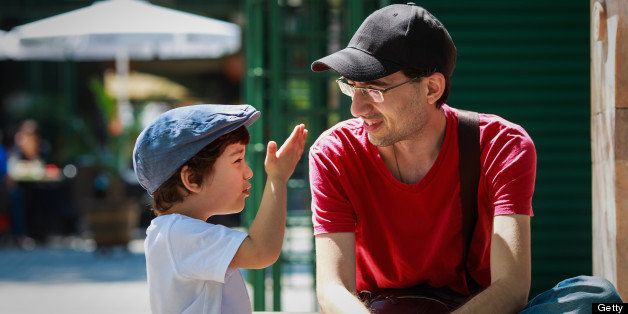
Being a parent means navigating high-stakes, sensitive conversations with your children. When it comes to talking about sex, parents generally want to be proactive. We know that one naive experiment can have lifelong consequences.
Sexual orientation, on the other hand, is a topic that often waits until the child or young adult initiates conversation. Parents are generally encouraged to wait until their child comes out to them, instead of jumping to conclusions.
I cannot imagine trying to decide how and when to speak to a child of color about racism and its manifestations in society. This conversation could have life-or-death consequences, especially given that police assume black boys are older and less innocent than white boys, and that Nextdoor.com users cultivate fear of their own neighbors with unchecked racial profiling.
What about talking to a child about her disability? Read just a few of numerous accounts of the relief experienced when individuals gain a name for their disability here, here and here. At the same time, be wary of unnecessary labels that could either downplay the challenges of disability or impose limitations.
For additional guidance, I sought out pediatric occupational therapist Jill Loftus, MS, OTR/L. She encouraged patience in allowing my child to bring up questions himself, in his own time, and answering those questions honestly. Being too proactive could cause confusion, anger or insecurity, with little likelihood of functional benefit. While talking with Jill, I realized that the backdrop for dialog within our family is possibly more important than the conversation itself. Fortunately, there are many ways I can provide a positive, nurturing environment while I wait for my son to come to me with questions. These strategies are just as helpful for typical siblings or families wanting to cultivate inclusiveness of disability at home.
First, read books that celebrate differences. Here are some of my favorites:
Janine by Maryann Cocca-Leffler
I love this book because it emphasizes the power of kindness, self-expression and inclusiveness. Janine doesn't change to meet others' expectations, but finds that they appreciate her quickly enough. I also enjoyed the appearance of a secondary character who uses a wheelchair.
Stick and Stone by Beth Ferry
This is a lovely story about two unlikely friends. It deals with bullying in an unusual way and stresses the importance of defending victims of bullying. It includes beautiful, dynamic illustrations by Tom Lichtenheld, known for his illustrations of Goodnight, Goodnight, Construction Site and Steam Train, Dream Train.
Swimmy and Frederick by Leo Lionni
Leo Lionni is possibly my favorite children's author. His stories are short, beautifully illustrated, poignant, and timeless. Swimmy does not shy away from exploring feelings of loss, fear, and loneliness. It celebrates new experiences and the power of an individual as well as a group. Frederick emphasizes the value of community, and recognizing one's own strengths and weaknesses without judgement.
Second, model accepting behavior for your child.
I assure you that you know multiple people who experience disability, although you may not realize it. Perhaps you know a college student with an ADHD diagnosis. A grandparent may be mobility impaired or experiencing other disabilities. Perhaps a neighbor has an accessible parking space outside her house, but you're not sure why. Allow yourself to reach out to these people in an accepting way, not a way that pushes them to fit your agenda or meet your expectations. This could take the form of an offer of paid babysitting or dog walking, a visit to a nursing home, an invitation to dinner, or simply introducing yourself and engaging in casual conversation.
Third, speak openly about disability in casual conversation at home.
It is okay to use diagnostic terms within earshot of your children. These might include phrases like, "Honey, don't forget I have the Down syndrome meeting tonight at 7," or "I read a great article about epilepsy today." Your child's diagnosis shouldn't be treated like an obscenity, a secret, or something that is not open for conversation.
Fourth, seek out cultural opportunities that model acceptance.
There are excellent groups dedicated specifically to individuals with disabilities, but also be aware of events that are inclusive without emphasizing disability. Cirque de Soliel features a very talented artist of short stature in Kurios. Attend live performances, or watch YouTube videos of spectacular artists such as Itzhak Perlman, Leon Fleisher, Evelyn Glennie, and Rachel Barton Pine.
Finally, allow yourself to make mistakes, and to talk about them.
"Last week I said I felt sorry for Timmy. That wasn't right. Really, I wish I knew more about him and his situation. Maybe next time I see him, I'll try to find out about some of his favorite things." When your child initiates dialogue about disability, accept that you will probably err. Chalk it up to another parenting story that will be hilarious decades from now. An important part of being an ally for your child and the disability community is accepting that you don't know everything about disability... which I find very comforting. I don't need to have all the answers, I just need to be respectful, curious, and willing to learn.